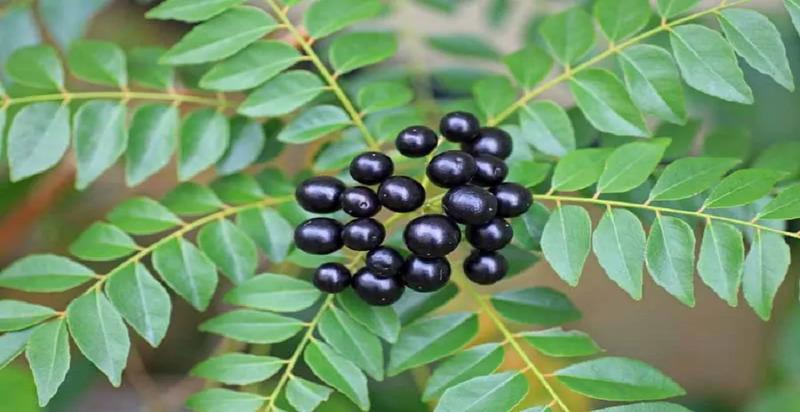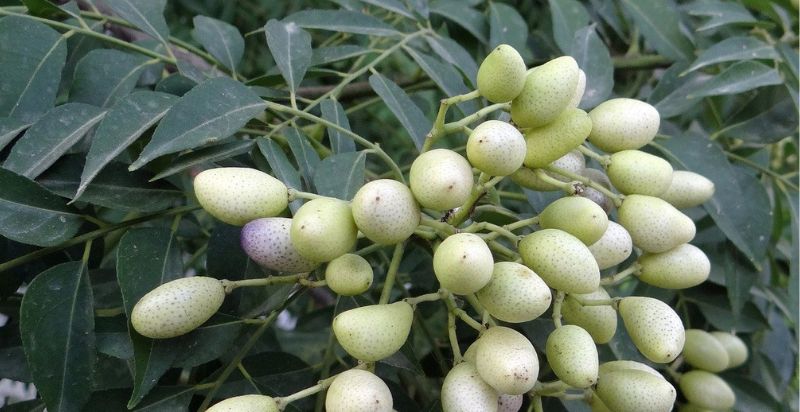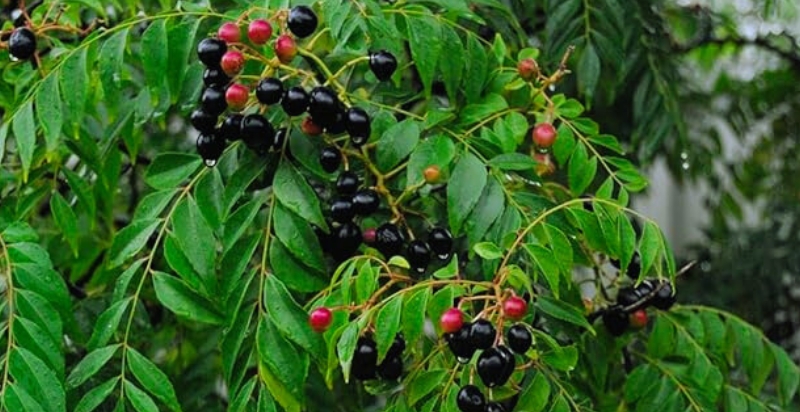Curry berries, also known as ghanti or kari phal (Carissa carandas), are a tropical fruit native to India. They are the only species in the genus Carissa and are members of the family Apocynaceae. Curry berries have been used for centuries in traditional Indian cooking, making them an important part of the country’s culture and cuisine. Here is a guide to everything you need to know about curry berries.
What are Curry Berries, and why are they so Popular?
Curry is a famous mix of spices used in Indian food, known for its sweet and savory taste. It’s made from leaves of the curry tree along with spices like cumin, turmeric, and coriander. There’s also something called a curry berry that grows on the same tree, but not many people know about it. These berries are tiny, about half an inch wide, and grow in big groups. They start green and then turn a shiny dark purple or black. The inside of the berry is juicy and light blue. Some people think it tastes strange at first, but others, like me, really like it because it’s different from the usual sweet berries we have in North America. The berries have some dark green seeds that are poisonous, but the berries themselves are safe to eat.
The tree these berries and leaves come from isn’t very big, more like a bush, and can grow up to 12 to 18 feet tall. It likes warm places with temperatures around 70 degrees Fahrenheit to start growing and doesn’t need a cold period to start. You can plant the seeds with the berry still on them or just use the seed. It might take a while for them to grow, sometimes up to 8 weeks, and not all seeds will turn into plants, so it’s a good idea to plant extra. Once they start growing, it takes about two years for them to become young trees. You can also grow new trees from parts of the plant. For this, you can use different types of soil or mixes, like coconut coir or sand mixed with perlite. Using a rooting hormone can help them grow better, and they need to be kept moist but not too wet, in a place that’s not too sunny at first.
They are also a good source of dietary fiber, which helps maintain a healthy digestive system. Curry berries are known for their medicinal properties and have been used in Ayurvedic medicine for centuries to treat infections, allergies, skin complaints, and other ailments.

History and Origin of the Curry Berries
Curry berries, known for their unique flavor, are tropical fruits originally from India and Southeast Asia. These berries have a rich history, being cultivated in India from ancient times. They hold a significant place in Hindu culture, as evidenced by their mentions in sacred texts such as the Ramayana, Mahabharata, and Manusmriti, highlighting their importance in the region’s heritage.
The use of curry berries can be traced back to the 16th century during the Mughal era in India, marking their long-standing culinary use. They were a key ingredient in preparing various traditional dishes, including curries, which showcased the versatility of these berries in enhancing flavors. Over the years, the cultivation of curry berries has spread globally, reaching far and wide to continents like Africa, South America, and the Caribbean. This expansion reflects the berry’s adaptability and growing popularity in different cuisines around the world.
In addition to their culinary uses, curry berries are also valued for their potential health benefits. They are rich in antioxidants and vitamins, which contribute to their nutritional profile. This aspect has sparked interest in incorporating curry berries into diets for their health-promoting properties. Furthermore, the cultivation of curry berries supports local agriculture in many regions, providing economic benefits and promoting biodiversity. As such, curry berries are not just a flavorful addition to dishes but also an important agricultural commodity with cultural, health, and economic significance.
Where Curry Berries are Grown and Harvested?
Curry berries are mostly grown in India but can also be found growing naturally in other warm and wet places. They love the heat and need plenty of sunshine to grow well.
In India, the places where you’ll find a lot of curry berries being grown include Andhra Pradesh, Karnataka, Maharashtra, Tamil Nadu, Telangana, Uttar Pradesh, and West Bengal. The best time to pick these berries is towards the end of summer or the beginning of fall, which is when they are perfectly ripe. These berries are not just popular for their taste; they are also part of many traditional dishes and have been used in Indian cooking for a long time. People value them for their unique flavor and the way they can enhance a meal. Plus, growing curry berries helps local farmers and supports the economy in these areas, making them an important crop beyond just their culinary use. Late summer is also a prime time to harvest many vegetables including bell peppers, peaches, tomatoes and zucchini.
How to Grow Curry Berries?
You can plant them with their flesh intact or just the naked seed itself in a pot filled with standard potting soil. Note that many seeds may not sprout, which makes it necessary to plant more than what is required. Germination can take anywhere from 6 to 8 weeks or several months. Choose the healthiest seedlings and keep them in a warm and well-lit place, preferably in shade. The seedlings will take approximately 2 years to develop into saplings. If you like to grow your plant in containers, increase the size of the pot as your plant grows. You can also grow them in your garden or backyard, provided you live in a suitable climate.
It is also possible to start a new tree from fresh stem cuttings. For this, choose curry leaves with petioles or stems still attached to the stem. The fruits are available in summer, and they grow in clusters of 32 to 80 fruits attached to their green stems. Its flowers are small, white, and scented, blooming in late spring to early summer. In certain tropical places, the berries grow multiple times a year.
Nutritional Content of Curry Berries
Curry berries are a good source of dietary fiber and contain essential vitamins like vitamins A, C, and K. They are also rich in iron, magnesium, phosphorus, potassium, and zinc. Moreover, curry berries have antioxidant properties that may help to reduce inflammation. Furthermore, they are low in calories and fat-free, which makes them a healthy snack.
Curry berries are packed with nutrients for your health. They have vitamin C, which helps keep your immune system strong and lowers swelling in the body. They also have calcium, important for strong bones and teeth, and phosphorus, which helps fix body cells. These berries even have some potassium, which keeps the fluids in your body balanced, iron, which is needed to make hemoglobin (a protein that carries oxygen in your blood), and magnesium, which helps your nerves work properly. The deep purple-red color of the berries comes from anthocyanins, special natural colors that act like antioxidants. These antioxidants help protect your cells from damage caused by oxidative stress and free radicals, which can harm your cells.

Flavor Profile of the Curry Berries
Curry berries have a sweet-tart taste with hints of nutmeg and clove. The flavor is similar to that of pomegranate or cranberry but sweeter. They can be eaten raw as a snack or cooked in dishes like curries and shakes.
Curry berries are really interesting when it comes to taste. At first, when you eat them, they are a little sweet. This sweetness is nice and not too strong. But there’s more to their taste than just sweetness. After a bit, you start to notice a slight spicy flavor. It’s a gentle kind of spice, not the kind that makes your mouth burn. Along with the sweet and spicy, there’s also a hint of something that tastes like herbs. It’s a really nice mix that’s not too strong in any one flavor.
These berries are great because you can eat them in different ways. They can be added to all sorts of recipes, both where you expect something sweet and where you want a bit of spice. They’re really versatile. Whether you’re cooking something or making a dessert, curry berries can add something special without covering up the other flavors in your dish.
Where to Find the Best Quality Curry Berries?
Curry berries can be found in most Indian grocery stores and online. They are usually sold dried or powdered, but fresh curry berries can also be found in some parts of India during harvest. When buying curry berries, look for firm ones with a deep red or purple color. Avoid any that are soft or discolored.
How to Pick and Store Curry Berries?
When shopping for curry berries, look for bright red ones that feel firm. Avoid using soft or wrinkled fruits, as they may have gone bad. If you buy fresh curry berries, store them in the refrigerator, where they will stay fresh for up to a week.
Curry berries can be stored for up to 3 days at room temperature. If you want to store them longer, freezing is the way to go. Curry berries can last up to 6 months when frozen. To freeze curry berries, first place them in airtight containers or wrap them in plastic. Place them in a freezer. When ready to use, take out the curry berries and allow them to thaw overnight in the refrigerator. This will make them ready for use the following day.
How to Use Curry Berries?
Curry berries can be eaten raw or cooked in curries, shakes, desserts, jams, and other dishes. They can also make butter, syrup, chutney, jam, and pickles. Curry berries are a great addition to salads and smoothies, adding a sweet-tart flavor. Furthermore, they can be used as a topping for yogurt or ice cream to add sweetness and texture.
Simple Recipe Using Curry Leaves:
Curry Leaf Chutney
- 1 cup (25 grams) of fresh curry leaves
- 2 tablespoons (10 grams) of sesame seeds
- 2 tablespoons (16 grams) of roasted peanuts
- 1 teaspoon (2.5 grams) of dried mango powder
- 1/2 teaspoon (1.5 grams) of red chili powder
- Pinch of sugar
- Pinch of salt
Makes 1 cup (325 grams) of chutney
What are the Health Benefits of Curry Berries?
Curry berries are packed with antioxidants, vitamins, and minerals. These little berries have been linked to multiple health benefits, such as promoting heart health, reducing inflammation, aiding digestion, and even improving brain function. Although more studies are still needed to explore their potential benefits, the nutritional content of curry berries suggests that they can be a valuable addition to any healthy, well-rounded diet.

Curry leaves, which resemble smaller bay leaves, are known for their aromatic scent and are a staple in many culinary dishes. These leaves not only enhance the flavor of food but are also believed to offer various health benefits. Traditionally used in practices like Ayurveda, curry leaves are thought to help with blood sugar control, digestion, and skin health.
It’s important to note, however, that while curry leaves are associated with these health benefits, it is advisable to consult with your doctor before incorporating them into your medication routine, especially for specific conditions like diabetes.
Historically used for dental hygiene, curry leaves are now sometimes used in natural dental products. They are also believed to aid in weight management and improve overall digestion. Regular inclusion in your diet could contribute to better health, but moderation and medical advice are key.
Curry leaves are known to be rich in vitamins and antioxidants, supporting a strong immune system and promoting overall well-being. They are good for eye health due to their vitamin A content and are believed to help maintain healthy skin. Remember, while curry leaves can be a healthy addition to your diet, it’s always best to consult with a healthcare professional for personalized advice.
Can Dogs Eat Curry Berries?
We are not sure what curry berries will do to your dog when ingested, so it is always wise to consult your veterinary doctor before you feed your dog something you need more clarification on.
Conclusion
Curry berries are an important part of India’s culture and cuisine. They have a sweet-tart flavor and contain essential vitamins and minerals that provide many health benefits. Curry berries can be enjoyed raw or cooked in dishes like curries, shakes, desserts, jams, and other dishes. Furthermore, they are a great way to add sweetness and texture to salads, smoothies, and yogurt. With numerous benefits and uses, curry berries are a must-have ingredient in your kitchen!
Frequently Asked Questions
Q1. What are Curry Berries?
The fruit of the curry tree (Murraya koenigii) is called curry berries or curry tree berries. The curry tree is a tropical to sub-tropical tree native to the Indian subcontinent. It is cultivated for its aromatic leaves, known as curry leaves, and its small, dark berries.
Q3. Can we Eat Curry Berries?
Curry berries are edible and come from the curry tree. They are small, dark berries with a distinctive flavor. Although they are not as popular as curry leaves, people use them in cooking to add a slightly sweet and nutty taste to sweet and savory dishes. Adding curry berries to your meals can give you a more diverse and flavorful culinary experience.
Q4. What Can You Do with Curry Berries?
Curry berries have a one-of-a-kind flavor that combines citrus, sweet, savory, and herbal notes. The best part is that they are versatile and can be added to a variety of dishes, whether sweet or savory. Try incorporating them into your baking, cooking, or even drinks to add a unique twist to your creations. You can use them in all sorts of recipes such as chutneys, marinades, salads, and desserts. Don’t be afraid to experiment and let your creativity shine through in the kitchen!
Q5. What Do Curry Berries Taste Like?
Curry berries have this amazing sweet and nutty taste, with a hint of bitterness. They are also quite aromatic, which adds a lot of depth to dishes. Although they’re different from the curry leaves that we usually associate with Indian cuisine, curry berries are a valuable ingredient in both sweet and savory recipes. You should definitely give them a try if you’re feeling adventurous in the kitchen!
- Fuerte Avocado: History, Flavor, Calories, Benefits, And Uses - March 27, 2024
- Everything You Wanted to Know About Barhi Dates - March 23, 2024
- Everything You Wanted To Know About Beech Mushrooms - March 23, 2024

6 thoughts on “Curry Berries: Benefits, Nutritional Facts & Uses”
Comments are closed.